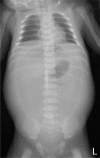Neonatal gastric perforation: a report of two cases and a systematic review
- PMID: 29702982
- PMCID: PMC5944554
- DOI: 10.1097/MD.0000000000010369
Neonatal gastric perforation: a report of two cases and a systematic review
Abstract
Rationale: Neonatal gastric perforation is a rare and life-threatening disorder in neonates and is associated with high morbidity and mortality. However, the exact mechanisms of neonatal gastric perforation remain unknown.
Patient concerns: In this study, we reported 2 cases of neonatal gastric perforation and conducted a systematic review to analyze the prognostic factors for mortality.
Diagnoses: Two neonates received a diagnosis of gastric perforation based on clinical presentation and imaging studies. The 2 patients underwent emergent surgery, which yielded favorable outcomes.
Interventions: We reviewed 168 cases from the literature as well as our 2 cases to analyze whether mortality in neonatal gastric perforation is associated with sex, gestational age, operation type, perforation location, or timing of perforation.
Outcomes: The results revealed that mortality was significantly higher in preterm neonates (n = 80, P < .01) and the mortality group had a lower birth weight (n = 73, P < .05). The timing of perforation in the preterm subgroup was significantly earlier than that in the full-term subgroup (n = 90, P < .05). The outcomes about mortality of gastric perforation were significantly associated with preterm neonates (adjusted odds ratio: 4.21, 95% confidence interval: 1.28-13.88, P < .05).
Lessons: This study shows the prognostic factor of gastric perforation was significantly associated with preterm neonates. Furthermore, low-birth-weight full-term neonates had a relatively higher mortality rate than the normal-birth-weight full-term neonates. In addition, preterm neonates have an earlier timing of perforation.
Conflict of interest statement
The authors have no conflicts of interest to disclose.
Figures
References
-
- Lin CM, Lee HC, Kao HA, et al. Neonatal gastric perforation: report of 15 cases and review of the literature. Pediatr Neonatol 2008;49:65–70. - PubMed
-
- Touloukian RJ, Posch JN, Spencer R. The pathogenesis of ischemic gastroenterocolitis of the neonate selective gut mucosal ischemia in asphyxiated piglets. J Pediatr Surg 1972;7:194. - PubMed
-
- Shaker IJ, Schaffer JA, James AE, et al. Aerophagia, a mechanism for spontaneous rupture of the stomach in newborn. Am Surg 1973;39:619–23. - PubMed
Publication types
MeSH terms
LinkOut - more resources
Full Text Sources
Other Literature Sources
Medical




